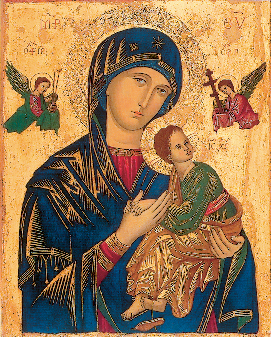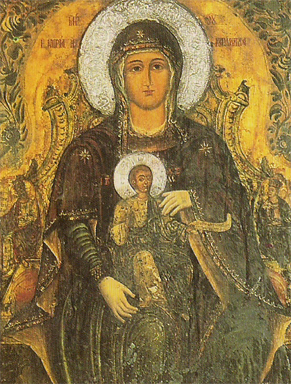Our Lady of Perpetual Help
Our Lady of the Heart, Kera, Hersonissos, Heraklion, Crete
Madonna del Perpetuo Soccorso, Rome, Italy
The Monastery of Kera Kardiotissa stands in a secluded woodland in the mountains of Crete. In the middle ages, it was famous for a miracle-working icon of the All-Holy Lady holding the Christ Child, known as the work of St. Lazarus of Constantinople (d. 867), an iconographer who was imprisoned and tortured during the reign of Theophilus the Iconoclast. The story goes that to escape destruction the icon took wing and found refuge in the Cretan monastery; but Theophilus had it returned to Constantinople, intending to destroy it personally. Once again it flew away to Kera. Again the emperor had it retrieved, this time chaining it to a pillar. It disappeared, turning up in Kera along with the pillar and shackles, which are still on display at the monastery.
 In 1498 a merchant succeeded in abducting the miraculous image, intending to
sell it. En route to Italy, a storm came up, threatening to sink the ship until
the trader begged the Virgin's help. Safe ashore, he took the painting to his
house in Rome, where he soon fell ill. On his deathbed he confessed to a friend
that he had stolen the icon and asked that he place it in a church. The friend
delayed fulfilling his promise because his wife wanted to keep the image. Then
their little girl saw the Madonna, who called herself the Lady of Perpetual Help
and asked that the icon be moved to a church "between the Basilicas of St. Mary Major and St. John Lateran." On March 27, 1499, the picture was
installed at that location in St. Matthew's Church, at the Augustinian Monastery
of St. Eusebius on the Esquiline Hill. There it remained until 1798, when
Napoleon's army captured the pope and leveled thirty Roman churches, including St.
Matthew's. The Augustinians moved the icon to a private chapel at their
Monastery of St. Posterula, near the Tiber River, where it stayed in obscurity
for 65 years. In 1855, the Redemptorist Fathers bought the site of old St.
Matthew's for a new motherhouse and chapel to be dedicated to the founder of
their order, St. Alphonsus Liguori.
In 1498 a merchant succeeded in abducting the miraculous image, intending to
sell it. En route to Italy, a storm came up, threatening to sink the ship until
the trader begged the Virgin's help. Safe ashore, he took the painting to his
house in Rome, where he soon fell ill. On his deathbed he confessed to a friend
that he had stolen the icon and asked that he place it in a church. The friend
delayed fulfilling his promise because his wife wanted to keep the image. Then
their little girl saw the Madonna, who called herself the Lady of Perpetual Help
and asked that the icon be moved to a church "between the Basilicas of St. Mary Major and St. John Lateran." On March 27, 1499, the picture was
installed at that location in St. Matthew's Church, at the Augustinian Monastery
of St. Eusebius on the Esquiline Hill. There it remained until 1798, when
Napoleon's army captured the pope and leveled thirty Roman churches, including St.
Matthew's. The Augustinians moved the icon to a private chapel at their
Monastery of St. Posterula, near the Tiber River, where it stayed in obscurity
for 65 years. In 1855, the Redemptorist Fathers bought the site of old St.
Matthew's for a new motherhouse and chapel to be dedicated to the founder of
their order, St. Alphonsus Liguori.
By 1863, those Catholic authorities who knew of the once-famous icon had no idea where it had gone. Preaching in Rome at the Church of the Gesu, Jesuit Father Francis Blosi told the story of Our Lady of Perpetual Help, hoping not only to inspire his hearers but to elicit clues. A Redemptorist, Michael Marchi, told Father Blosi that the icon had been at St. Posterula's when he served there as an altar boy. It proved to be there still.
When Pius IX heard the news, he asked the Redemptorists to move the picture to their new motherhouse between the Basilicas of St. Mary Major and St. John Lateran, and to spread devotion to Our Lady of Perpetual Help. At once the Redemptorists began fulfilling the Pope's request, enshrining the icon in their new Church of St. Alphonsus on the Esquiline Hill, holding weekly novena prayer services before it, and preaching devotion to Our Lady of Perpetual Help in their missions around the world. Soon, there were shrines to Our Lady of Perpetual Help in many countries, often with miracles attributed to her intercession. Some of these include: Catholic cathedral, Prizren, Kosovo (1870); Basilica, Roxbury, Massachusetts, USA (1878); Basilica, Brooklyn, New York, New York, USA (1894); Catholic cathedral, Oklahoma City, Oklahoma, USA (1924); Cathedral, El Vigía, Mérida, Venezuela (1944); National Shrine, Baclaran district, Parañaque, Metro Manila, Philippines (1958); Basilica, Labrador City, Newfoundland and Labrador, Canada (1962); Catholic cathedral, Rapid City, South Dakota, USA (1963); Pro-cathedral of the Cracow-Czestochowa diocese, Strzyzowice, Silesia, Poland (1965); Catholic cathedral, Astana, Kazakhstan (1999). She is the patron saint of Haiti.
In 1876, Pope Pius IX established a feast of Our Lady of Perpetual Help on the Sunday after that of St. John the Baptist (June 24). In a decision dated April 28, 1914, the Sacred Congregation of Rites moved the celebration to June 27.
 The icon of Our Lady of Perpetual Help
(above) is of the type known in Orthodoxy as
the Mother of God of the Passion. Mary holds Jesus in her left hand, both
gesturing toward him and clasping his left hand with her right. The Christ child
looks up nervously at angels bearing the instruments of his future crucifixion,
while his mother looks toward the viewer with knowing sadness. Neither notices
that the boy is losing his sandal. The earliest known image of this type is
a fresco painted in a church in Cyprus in 1192, commissioned by a Byzantine
aristocrat displaced by Western occupation. In Crete, the artist Andreas Ritzos
painted at least three icons of the Virgin of the Passion between 1451 and 1492,
standardizing and popularizing the image. When the Vatican Museum restored the
Roman icon of Our Lady of Perpetual Help in 1990, technicians carbon-dated it to
1325-1480.
The icon of Our Lady of Perpetual Help
(above) is of the type known in Orthodoxy as
the Mother of God of the Passion. Mary holds Jesus in her left hand, both
gesturing toward him and clasping his left hand with her right. The Christ child
looks up nervously at angels bearing the instruments of his future crucifixion,
while his mother looks toward the viewer with knowing sadness. Neither notices
that the boy is losing his sandal. The earliest known image of this type is
a fresco painted in a church in Cyprus in 1192, commissioned by a Byzantine
aristocrat displaced by Western occupation. In Crete, the artist Andreas Ritzos
painted at least three icons of the Virgin of the Passion between 1451 and 1492,
standardizing and popularizing the image. When the Vatican Museum restored the
Roman icon of Our Lady of Perpetual Help in 1990, technicians carbon-dated it to
1325-1480.
Another icon (right) has become famous for miracles at Kera Monastery in Crete. A work of the 1700s, today's All-Holy One of the Heart is of a different iconographic type, though sometimes called a copy of the stolen original. With both hands, Mary steadies Jesus in a central position on her right knee. Both gaze out at the viewer. The child holds an open scroll with his left hand and gives a blessing with his right. There are no angels or Passion symbols. Instead, the mother and child are flanked by Kings David and Solomon.
In the 1900s a shortage of monks prompted the Orthodox Archbishop of Crete to change Kera from a male to a female monastery. Dedicated to the Nativity of Mary, it celebrates its feast day on September 8.
Sources include:
|